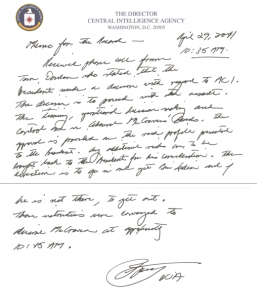Why Not Have a Hearing on Civilian Drone Casualties?
Yesterday, I suggested that Mike Rogers and Dutch Ruppersberger’s certainty that public accounts of drone casualties are overstated may say more about our failed intelligence oversight than it does about the number of civilians who have died in our drone strikes.
Later yesterday, Steven Aftergood posted a must read reflection on how our intelligence oversight has backed off public accountability. I’ll have more to say about Aftergood’s post, but for the moment I wanted to look at a measure of public accountability he uses: the number of public oversight hearings, particularly those with outside experts.
Over the past decade, however, the Committee’s priorities appear to have changed, to the detriment of public accountability. In fact, despite the Committee’s assurance in its annual reports, public disclosure even of the Committee’s own oversight activities has decreased.
In 2012, the Committee held only one public hearing, despite the prevalence of intelligence-related public controversies. That is the smallest number of public hearings the Committee has held in at least 25 years and possibly ever. A non-governmental witness has not been invited to testify at an open Committee hearing since 2007.
Breaking! Under Dianne Feinstein’s leadership, the Senate Intelligence Committee has had its fewest public hearings in at least 25 years!
Aftergood’s point, though, suggests one remedy for the problem with Mike Rogers’ boasting (or more lucrative assurances from DiFi that her oversight is all we need on drone strikes).
Why not have a public hearing at which the major contributors to the discussion of drone casualties testify in the same place?
The Intelligence Committees could invite both The Bureau for Investigative Journalism and the AP to explain how they conducted independent assessments of civilian casualties and what those assessments showed. They could invite Peter Bergen to explain his dubious numbers publicly (at one point, after all, Bergen actually knew as much about Osama bin Laden as the people hunting him in secret). They could invite Pepperdine professor Gregory Neal–who has a paper saying that when the government uses its collateral damage estimation process, it does a remarkably good job at keeping collateral damage low, but admits that “due to the realities of combat operations, the process cannot always be followed.” Hell, they could even invite John Brennan to lie publicly about civilian casualties, as he has done in the past. Maybe, too, Brennan can explain how all militant age men are treated and counted, by default, as militants.
The point is there is a partial remedy to the grave problems with the cognitive challenges overseers like Mike Rogers and Dianne Feinstein face. One of those is to publicly accept the testimony of those who have different investments than the intelligence community.
Right now, continuing to rest the drone program’s legitimacy on repeated public calls to “trust me” actually undermines its legitimacy.
Sadly, resting our national security policy on repeated “trust mes” appears to be what Rogers and Feinstein like.

